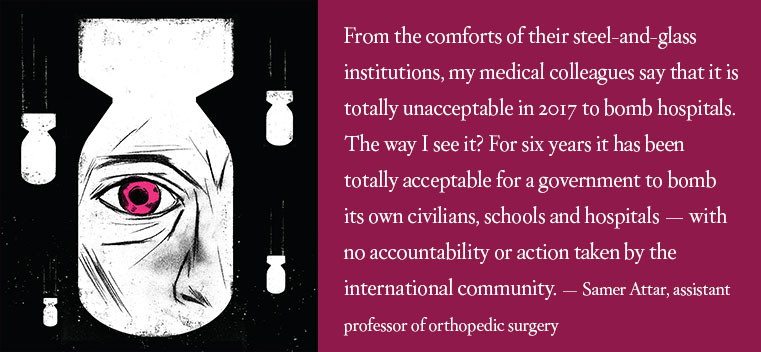
Aleppo’s True Heroes
Samer Attar, an assistant professor of orthopedic surgery at the Feinberg School of Medicine, served as a volunteer with the Syrian American Medical Society and the Aleppo City Medical Council from 2013 to 2016.
Tell us what you think. E-mail comments or questions to the editors at letters@northwestern.edu.
Find Us on Social Media
Northwestern doctor recounts treating patients in the hell of a war zone — and praises the Syrian people who tried to support life.
“She died.” I got all too used to hearing those words when I volunteered in an Aleppo field hospital this past July and asked what happened to patients. I was the last American doctor out of Aleppo before Syrian government forces encircled and besieged the city.
People ask me what Aleppo was like when I worked there. I say it was the closest I’d ever been to hell. From helicopters, jets and cannons came bombs that fell from the sky, pummeled buildings into rubble, ripped them apart and gutted them open.
What these bombs did to the human body was far more horrifying. But I saw it every day, and I became numb to it. Fifty people massacred in one day is what they called Tuesday. We witnessed children’s bodies shredded to pieces, blasted in half at the waist, and burned beyond recognition. We were helpless to stop it.
On my first day I barely had time to change into scrubs before I met the first few patients. I saw a young mother who was newly paralyzed. A barrel bomb had landed on her home. Her family had pulled her from the rubble and delivered her to the hospital. They were covered in dry blood and gray dust; they looked as if they were made out of stone. Aleppo’s only neurosurgeon attempted to open her spinal canal to relieve pressure on her spinal cord in a last-ditch effort, but it didn’t work. She would never walk again.
Next to her was another young mother — on life support. A barrel bomb had also hit her home. Her son and daughter were killed in the attack. She had been pregnant, but the blast also killed her unborn baby. When her husband, who was working at his shop across the street, ran home after surviving the first blast to check on his family, a helicopter dropped a second barrel bomb. Both father and mother survived — left only with scars and dead children.
Next to her was an 8-month-old girl suffering from convulsions. Shrapnel had penetrated her head, and she bled into her brain. The neurosurgeon opened her skull and evacuated the blood — saving her life.
The lucky ones were pulled alive from the rubble. I wondered how many were buried alive underneath their collapsed homes. Even if rescued, what was their chance of survival in an ambulance driving through streets being shelled? Or in a basement field hospital with no anesthesia, no antibiotics and no blood transfusions? It’s hard to remain poised and steadfast when there is a very high likelihood you may end up on the floor dead or crippled next to the patients you are trying to save.
Every time I traveled to Aleppo, I worked in a field hospital code-named M10, which was funded primarily through donations from Americans. Hospitals are targets in the Syrian conflict, so they are built underground and fortified with barrels and sandbags to protect the structure from bomb blasts. Sometimes we’d be so overrun and overwhelmed that we’d operate on patients lying on floors puddled with blood.
M10 hospital was eventually destroyed by sustained aerial bombardment in October 2016.
Aleppo has since fallen. One of the oldest, continuously inhabited cities in the world — rich in living history and culture — it will be remembered along with Srebrenica and Rwanda and other epicenters of the mass slaughter of innocents as the world stood by and did nothing.
From the comforts of their steel-and-glass institutions, my medical colleagues say that it is totally unacceptable in 2017 to bomb hospitals. The way I see it? For six years it has been totally acceptable for a government to bomb its own civilians, schools and hospitals — with no accountability or action taken by the international community. The United Nations’ collective failure and incompetence in Syria clearly demonstrate this message.
Rebel-held eastern Aleppo in particular was turned into a living hell, where people endured fear and horror to stay alive. Would they have preferred to risk drowning on a boat trying to get to a country where they would be criminalized as terrorists? Or would they rather have risked moving to Damascus or government-held Aleppo, where they likely would have been arrested and tortured?
The real heroes of Aleppo are the local Syrian medics, schoolteachers and rescue workers who braved these conditions. They worked in underground schools, hospitals and orphanages with no protection from artillery and airstrikes. They did so knowing full well that, up until the end of it all, they were abandoned by the world and totally on their own.
They taught me what true resilience and courage mean. When anyone asks me about Aleppo, I say that these are the people who should be remembered.



 Facebook
Facebook Twitter
Twitter Email
Email


